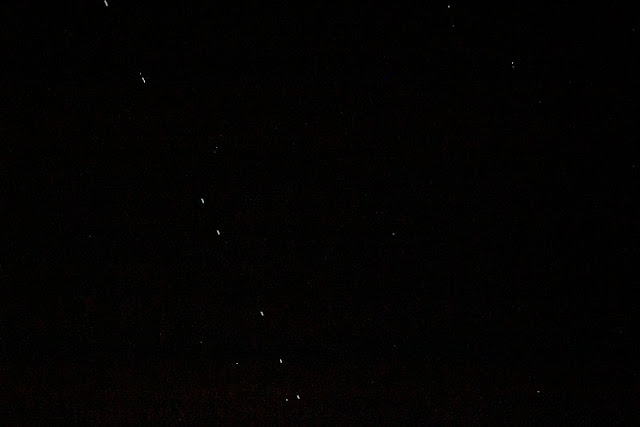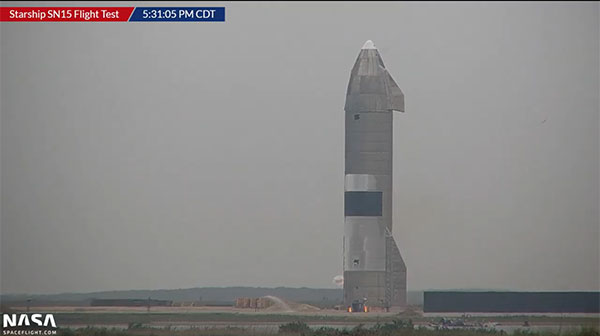Greetings from Palmia Observatory
First up, let's update the calendar for the upcoming AAS DDA (Division of Dynamic Astronomy) 52nd meeting which runs from May 17-21, 2021.
This is a technical meeting so be ready for study and looking up terms and concepts that are not directly on the the tip of your tongue. See you there and if you haven't signed up yet, check out the details at: https://aas.org/meetings/dda52
 |
| Upcoming DDA 52nd meeting will be held online (Source: https://aas.org/meetings/dda52) |
The big news for night sky observing, here in the city lights of OC, was the passage, high overhead, of the latest batches of Starlink satellites. Each Starlinks launch is made up of a batch of 60 satellites which are arranged in a straight line and are eventually boosted into their final operating orbit. Heavens Above prediction was excellent for location and observing time. Next time I want to use a shorter focal length, something like 18mm or maybe 15mm to get more of the satellites in the frame at the same time.
This photo shows some of the satellites. The overhead passage was quite spectacular with naked eye observing and the dim dots of light showed up as a string of pearls as they marched across the sky. When the satellites are boosted to their higher, operational elevation they will not be visible for naked eye observing.
 |
| Some Starlinks satellites, DSLR, 38mm, 1/4 second (Source: Palmia Observatory) |
In addition to watching for Starlink satellites, we followed the preparation and eventual test hop of Starship SN15 prototype from Boca Chica. Here we see the Starship after successfully completely a test, even though there was a small fire at the end of the landing. The fire was extinguished and looks fine.
 |
| Starship SN15 makes soft landing and ignites a small fire (Source: NASASpaceflight.com) |
We wanted to be some of the spectators for this test hop but couldn't fit it into our schedule. Here you see a lot of visitors just enjoying the beach on South Padre Island and watching the launch from six miles away. This observing site looks ok, although there were a lot of low clouds, but for me, I would prefer to be up in one of the high rise hotel balconies, sipping on a margarita, while waiting for the launch!
 |
| Some SpaceX spectators on South Padre Island (Source: NASASpaceflight.com) |
In other SpaceX news, the crew members of the upcoming all-civilian orbital flight of the Dragon spacecraft have been selected and ready for training. The crew members were selected by a lottery in recognition of raising charity funds for St. Jude Children's Hospital. The multi-day orbital flight was purchased by Jared Isaacman, who earned billionaire status for developing an internet payment company. Jared then selected the other three volunteers to go on the ride with him. Hmm, if you won the lottery to ride in the capsule would you go ahead with it?
 |
| The four civilian crew for Inspiration 4 (Source: SpaceX) |
This week's lecture presented by the Simons Foundation was given by Professor Paul Steinhardt, Princeton University. Steinhardt has been developing alternative theories to inflation for several years. He contends that inflation, although it seems to solve many of the problems with the big bang cosmology, is itself without an explanation or theory as to how it started or how it ends. He has been developing the idea of cyclical universes and colliding branes.
Now he introduces us to the "bouncing cosmology" model to explain the observed effects from the CMB onward without introducing the idea of inflation.
 |
| Take the Big Bang out of the Big Bang Theory (Source: Paul Steinhardt, Simons lecture) |
The bouncing cosmology model is supposed to explain the actual measurements without the problems with inflation. I didn't understand all of the details. I did recognize that many physicists realize the problems with inflationary theory at the same time as understanding how it was used to solve some of the major problems in cosmology, like the observed flatness of the universe. A key part of the problem which he hopes to solve is how the universe started off in a low entropy condition when theories of quantum gravity indicate high entropy conditions. My own studies include tracing the degree of entropy from the big bang to evolution of galaxies to the formation of black holes and their eventual evaporation.
 |
| Bouncing cosmology as better fit than inflationary models (Source: Paul Steinhardt, Simons lecture) |
So the bouncing cosmology model posits a "slow contraction", whatever that means, which then transitions to the equivalent big bang, without a singularity and without the need for inflation. I kind of like the idea because the idea of a big bang just springing from a singularity has its own problems. But, I don't understand how all of it is supposed to work. If you want to dig more into the details, go to the Bouncing Cosmology website at: https://bouncingcosmology.com/ or https://paulsteinhardt.org/bouncing-cosmology/
 |
| Bouncing cosmology and slow contraction model (Source: Paul Steinhardt, Simons lecture) |
Finally, I don't know about you, but my sense is that my automobile dashboard is really lonely. Normally, that is before the pandemic, I would have gathered 4-5 university parking lot coupons per week. So, you can imagine that after a while there we be a big pile of coupons building up until I finally decided to clean them all out and get ready for the next batch to start to arrive. But now, I too miss all of the in person encounters and now without seeing a parking coupon for over a year now, even the car is missing out! Is your dashboard feeling lonely?
 |
| Lonely automobile dashboard misses all the parking lot coupons (Source: Palmia Observatory) |
Until next time, here from our burrow, stay safe, as we recover more of our freedom,

No comments:
Post a Comment